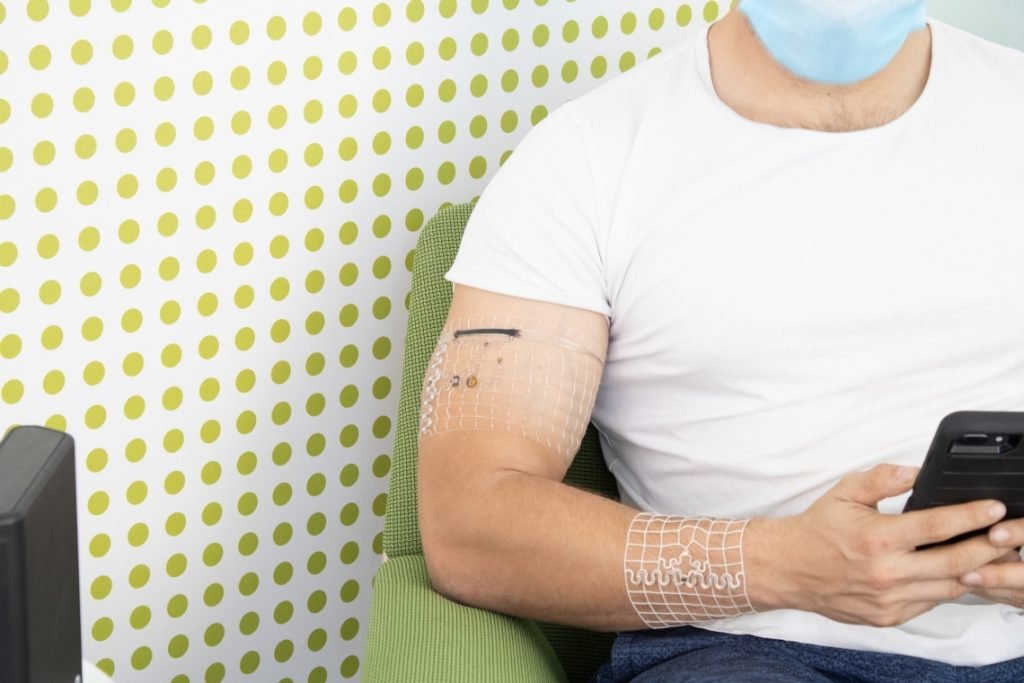The new devices, custom made to fit individuals, could mean massive improvements in the ability to monitor and treat diseases, test new drugs, and track individual health.

Engineers at the University of Arizona have developed a way to 3D-print medical-grade wearable devices like this one, based on scans of the wearer’s body. Philip Gutruf/College of Engineering
Wearable sensors are almost ubiquitous to monitor everything from step count to heart rate. But for scenarios such as measuring the onset of weakness in older adults, quickly diagnosing fatal diseases, testing the efficacy of new drugs, or tracking the performance of professional athletes, medical-grade equipment is needed.
Engineers at the University of Arizona have developed a type of wearable they call a “biosymbiotic device,” which has many unprecedented benefits. Not only are the devices custom 3D-printed and based on the wearers’ body scans, but they can also operate continuously using a combination of wireless power transfer and compact energy storage. Philip Gutruff, assistant professor of biomedical engineering and Craig M. The team, led by a Burges Faculty Fellow, published their findings today in the journal Science Advances.
“There’s nothing like it out there,” said Gutruf, a member of the university’s BIO5 institute. “We introduce an entirely new concept of directly tailoring a device to an individual and using wireless power casting to allow the device to operate 24/7 without ever needing to recharge.”
Custom fit enables precise monitoring
Current wearable sensors face various limitations. For example, smartwatches need to be charged, and they can collect a limited amount of data due to their placement on the wrist. Using 3D scans of the wearer’s body, which can be gathered through methods including MRIs, CT scans, and even carefully combined smartphone images, Gutruf and his team create images around different parts of the body. Can 3D-print custom-fitted devices that wrap on the side. Think about a virtually noticeable, lightweight, breathable, mesh cuff designed specifically for your biceps, calves or torso. The ability to specialize in sensor placement allows researchers to measure physiological parameters that they could not otherwise.
“If you want something close to a constant body core temperature, for example, you want to place the sensor on the side. Or, if you want to measure the way your biceps deform during exercise, we’re going to put the sensors in the instruments. One can implant a sensor. Which can accomplish this, said Tucker Stuart, a doctoral student in biomedical engineering and first author on the paper. “The way we fabricate the device and attach it to the body, we collect data. are able to use it for, a traditional, wrist-mounted wearable device would not be able to collect.”
Since these biosymbiotic devices are custom fit for the wearer, they are also highly sensitive. Gutruff’s team tested the device’s ability to monitor parameters, including temperature and stress, while a person jumped, walked on a treadmill and used a rowing machine. In the rowing machine test, subjects wore multiple equipment, tracking exercise intensity and the way the muscles were deformed with fine detail. The instruments were accurate enough to detect changes in body temperature induced by a single flight of stairs.
Continuous, wireless and seamless
Gutruf and his team aren’t the first to customize wearables to track health and body function. However, existing wearables do not have the ability to track metrics consistently, or with sufficient accuracy to draw clinically meaningful conclusions.
There are some wearable patches used by researchers that stick to the skin, but they come off when the skin goes through its normal shedding process, or sometimes when a subject sweats. Even highly sophisticated wearables used in clinical settings, such as ECG monitors, face these issues. In addition, they are not wireless, which severely limits mobility. If patients are tied to heavy external equipment they cannot go about their normal daily routine.
The biosymbiotic device that Gutruf’s team introduced has no adhesive, and derives its power from a wireless system with a range of several meters. The device also includes a small energy storage unit so that it will function even when the wearer is out of range of the system, including when outside the home.
“These devices are designed to require no interaction with the wearer,” Gutruff said. “It’s as simple as turning on the device. Then you forget about it, and it does its job.”

